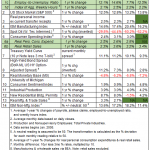As earnings season begins for Q1 2017 reports, there isn’t much change in analysts’ estimates for S&P 500 companies for that quarter. The latest figures from S&P shows expected earnings (as reported) of $26.70 in Q1, as compared to $26.87 two weeks ago. That is down only $1 from October, which is actually pretty steady particularly when compared to Q4 2016 estimates that over the same time plummeted from $29.04 to $24.16. At $26.70, that would represent about 23% growth over Q1 2016.
If history holds, of course, actual EPS will be substantially less than that. It has become standard ritual to watch each quarter unfold in considerable disappointment. Given that history, it was unusual to find that in just the two weeks since the March 23 estimates were published (to the latest of April 6) analysts have become suddenly more optimistic for later this year and especially 2018. Rarely do earnings estimates that far out get much if any boost, particularly because they start out so highly positive to begin with.
The expectation for Q4 2017, for example, was on February 21 $32.12; cut down to $31.41 as of March 23. The latest for April 6, however, is suddenly $32.43; above even the figure from late February. For Q4 2018, estimates were $34.68 in February, $33.46 at the end of March, but now $35.70.


Though I can’t know for sure what analysts are thinking, it seems reasonable to assume that their forecasts were changed by the FOMC “rate hike” in March. It appears as if they are translating what for the mainstream is more “hawkishness” by the textbook definition of it, meaning the Fed attempting to get ahead of an improving, perhaps rapidly, economy.
It is a wonder to behold because it shows the utter incapacity for learning, let alone scientific principles. The models are the models no matter how much empirical refutation they have been subjected to time and again.


It’s even worse in this case because of very recent history. Earnings departed from the QE3 path almost three years ago, and only to keep deviating from it all the while since. Admittedly, this recent upward adjustment isn’t a large one, but the very fact that it is upward makes it stand out in astonishment. In other words, the same reasons analysts may have used to perform these more optimistic calculations are the same reasons economists can’t figure out the bond market.












Leave A Comment